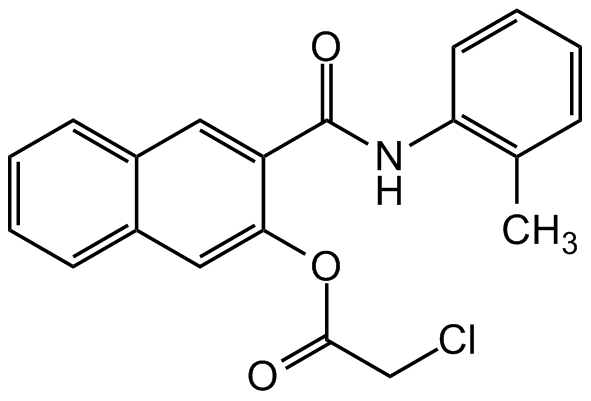Naphthol AS-D chloroacetate
| Code | Size | Price |
|---|
| CDX-N0245-M500 | 500 mg | £150.00 |
Quantity:
| CDX-N0245-G001 | 1 g | £231.00 |
Quantity:
Prices exclude any Taxes / VAT
Overview
Regulatory Status: RUO
Shipping:
Ambient
Storage:
Short term: +4°C, Long term: -20°C
Images
Documents
Further Information
Alternate Names/Synonyms:
3-Hydroxy-2-naphthoic-o-toluidide chloroacetate
Appearance:
White to off-white powder.
CAS:
35245-26-2
EClass:
32160000
Form (Short):
solid
Handling Advice:
Keep under inert gas.Very hygroscopic.
InChi:
InChI=1S/C20H16ClNO3/c1-13-6-2-5-9-17(13)22-20(24)16-10-14-7-3-4-8-15(14)11-18(16)25-19(23)12-21/h2-11H,12H2,1H3,(H,22,24)
InChiKey:
FMVKYSCWHDVMGO-UHFFFAOYSA-N
Long Description:
Chemical. CAS: 35245-26-2. Formula: C20H16ClNO3. MW: BD9837. Naphthol AS-D chloroacetate (NASDCA) is a fluorigenic substrate for granulocyte specific esterases (e.g. Proteinase 3 (PR3) and Cathepsin G). It can be hydrolyzed into Naphthol AS-D by esterases to mix with diazonium salt and form insoluble red-brown precipitate in the cytoplasm that can be visualized under a microscope. This enzyme is usually considered specific for cells of granulocytic lineage. NASDCA can be used for the visualisation of cells in formalin-fixed or paraffin-embedded tissue in a substrate solution for naphthol-AS-D-chloroacetate-esterase (CIAE) staining. Proteinase 3 (P3R) is a serine protease that is found in neutrophils and a subpopulation of monocytes. It is the most specific enzyme for NASDCA hydrolysis, and it is used in a variety of diagnostic tests to detect granulocytes. Cathepsin G is another serine protease that is found in neutrophils. It can also hydrolyze NASDCA, but it is not as specific as PR3. Human leukocyte elastase is a serine protease that is also found in neutrophils. It can hydrolyze NASDCA, but it is not as specific as PR3 or cathepsin G. It is important to note that not all granulocytes will stain positive for NASDCA. Basophils and eosinophils do not contain PR3, so they will not stain positive for NASDCA. However, neutrophils and a subpopulation of monocytes do contain PR3, so they will stain positive for NASDCA.
MDL:
MFCD00042714
Molecular Formula:
C20H16ClNO3
Molecular Weight:
353.8
Package Type:
Vial
Product Description:
Naphthol AS-D chloroacetate (NASDCA) is a fluorigenic substrate for granulocyte specific esterases (e.g. Proteinase 3 (PR3) and Cathepsin G). It can be hydrolyzed into Naphthol AS-D by esterases to mix with diazonium salt and form insoluble red-brown precipitate in the cytoplasm that can be visualized under a microscope. This enzyme is usually considered specific for cells of granulocytic lineage. NASDCA can be used for the visualisation of cells in formalin-fixed or paraffin-embedded tissue in a substrate solution for naphthol-AS-D-chloroacetate-esterase (CIAE) staining. Proteinase 3 (P3R) is a serine protease that is found in neutrophils and a subpopulation of monocytes. It is the most specific enzyme for NASDCA hydrolysis, and it is used in a variety of diagnostic tests to detect granulocytes. Cathepsin G is another serine protease that is found in neutrophils. It can also hydrolyze NASDCA, but it is not as specific as PR3. Human leukocyte elastase is a serine protease that is also found in neutrophils. It can hydrolyze NASDCA, but it is not as specific as PR3 or cathepsin G. It is important to note that not all granulocytes will stain positive for NASDCA. Basophils and eosinophils do not contain PR3, so they will not stain positive for NASDCA. However, neutrophils and a subpopulation of monocytes do contain PR3, so they will stain positive for NASDCA.
Purity:
>99% (HPLC)
SMILES:
O=C(NC1=C(C)C=CC=C1)C2=CC3=CC=CC=C3C=C2OC(CCl)=O
Solubility Chemicals:
Soluble acetone (50 mg/ml).
Source / Host:
Synthetic
Transportation:
Non-hazardous
UNSPSC Number:
41105331
Use & Stability:
Stable for at least 2 years after receipt when stored at -20°C.
References
(1) W.C. Moloney, et al.; Histochem. Soc. 8, 200 (1960) | (2) L.-D. Leder; Blut 21, 1 (1970) | (3) A. Vaughan, et al.; Anal. Chem. 43, 721 (1971) | (4) R. Rindler, et al.; Blut 26, 239 (1973) | (5) D.M. Swirsky; J. Clin. Pathol. 37, 1187 (1984) | (6) K.-W. Lam, et al.; Stain Technol. 60, 169 (1985) | (7) M.G. Braun, et al.; Hematol. Oncol. 14, 83 (1996)



